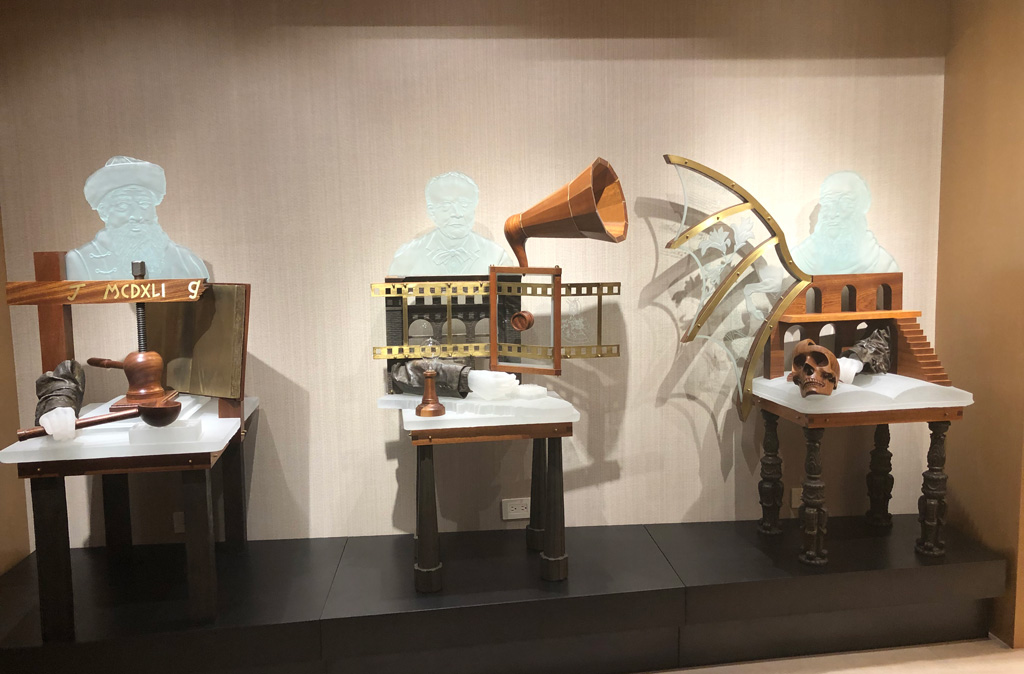Colloquium
Materials Sandblasted glass, cast glass, cast bronze, cold-formed brass, and wood
Collection Carol and Ed Kaplan, Highland Park, IL
This sculpture is a conversation between three of the most important inventors in history, and how they and their inventions relate to the advancement of education. The cast of characters consists of Thomas Edison, Leonardo Da Vinci, and Johann Gutenberg.
Following is an inventory of the elements of the sculpture and what they represent.
THOMAS EDISON
Legs of the chair: A representation of the Edison Memorial Tower in New Jersey. Seat: A map of lower Manhattan with a section of the city in relief, which represents the very specific area that had the first urban electrification. This was provided by the first electrical generating facility which was devised by Edison.
Background Building: This bronze is the facade of the Edison Laboratories, which was the first facility where design and research were conducted an a collective process with Edison being the conductor of the orchestra.
Film Strip and Camera: Invention and production of motion pictures. Gramophone: Invention of sound recording and playback. Image in filmstrip on the right: This is the stock ticker, which was Edison’s first major Invention. He proposed selling it to the industrialist Jay Gould hoping to get $3000 Gould offered him $40,000 which financed the beginnings of the Edison Laboratories.
Light bulb: The bulb in the piece is a reproduction of the first commercially produced bulb.
LEONARDO DA VINCI
Legs of the chair: Reproduction from Renaissance Florentine furniture.
Seat: Reproduction of a folio in which Da Vinci made copious notes and sketches concerning his far-ranging studies. The text was done in his famous mirror writing style.
Background Architectural Wood Piece: This is a symbol of his architectural studies and is adapted from his painting “Adoration of the Magi”
Wing: This is a reproduction from his pioneering work in the invention of flying Machines.
Panels in the Wing: (From top to bottom) 1. Two separate bars of music composed by Da Vinci. 2. Botanic drawings from the folios. 3. Structural architecture and engineering drawing for a building and drawing showing the anatomy and structural proportions of a horse.
Skull: Reproduced from drawings done during Leonardo’s dissections and medical studies
JOHANN GUTENBERG
Legs of the chair: Reproduction from his printing press.
Seat: The press bed with a mold at the front into which Gutenberg poured the first moveable type He formulated the alloy, which was used to create the reusable letters that revolutionized the printing process and remained in place for nearly 700 years.
Background Press Structure: Support for the screw section of his press, which was adapted from the principal of the wine press. The roman numeral date (1441) of his invention and his initials
Bronze Bible: This shows the laser etched Latin text of the first page of Genesis and one of the interior pages of the first book printed with this moveable type. I chose these pages to illustrate that he changed from a 42-line format to a 44-line format to shorten the number of pages. These pages also include reproductions of the illuminated margins, which were added after the printing.
Each one of the three figures also contain a bronze arm in period clothing and a cast glass hand in the act of creation.
